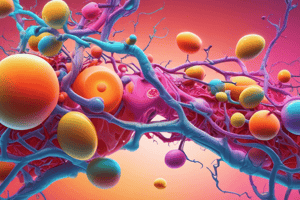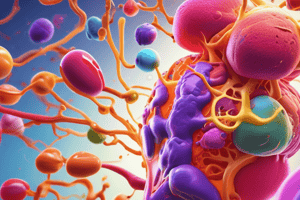Podcast
Questions and Answers
What is the final electron acceptor in aerobic respiration?
What is the final electron acceptor in aerobic respiration?
- Carbon dioxide
- NADH
- FADH₂
- Oxygen (correct)
Which of the following processes occurs in the cytoplasm?
Which of the following processes occurs in the cytoplasm?
- Glycolysis (correct)
- Electron Transport Chain
- Pyruvate Oxidation
- Krebs Cycle
What is the main purpose of photosynthetic pigments?
What is the main purpose of photosynthetic pigments?
- To absorb light energy (correct)
- To produce ATP directly
- To split water molecules
- To release CO₂
During the Krebs Cycle, which of the following is produced?
During the Krebs Cycle, which of the following is produced?
What is the role of fermentation in cellular respiration?
What is the role of fermentation in cellular respiration?
What happens during ATP hydrolysis?
What happens during ATP hydrolysis?
Which of the following statements describes an exergonic reaction?
Which of the following statements describes an exergonic reaction?
What drives the synthesis of ATP during the light-dependent reactions of photosynthesis?
What drives the synthesis of ATP during the light-dependent reactions of photosynthesis?
Which process utilizes light energy to convert CO₂ into sugar?
Which process utilizes light energy to convert CO₂ into sugar?
Which of the following correctly describes the role of Rubisco in the Calvin Cycle?
Which of the following correctly describes the role of Rubisco in the Calvin Cycle?
How does cyclic electron flow differ from noncyclic electron flow in photosynthesis?
How does cyclic electron flow differ from noncyclic electron flow in photosynthesis?
What process is responsible for the regeneration of RuBP in the Calvin Cycle?
What process is responsible for the regeneration of RuBP in the Calvin Cycle?
What is the primary purpose of phosphorylation in cell metabolism?
What is the primary purpose of phosphorylation in cell metabolism?
Flashcards
FADH₂ vs. NADH in ETC
FADH₂ vs. NADH in ETC
FADH₂ enters the electron transport chain later than NADH, producing less ATP.
Cytochrome's role in ETC
Cytochrome's role in ETC
A protein in the electron transport chain that facilitates electron transfer and pumps H⁺ ions.
Oxygen's function in respiration
Oxygen's function in respiration
Final electron acceptor in aerobic respiration, forming water.
Krebs Cycle output
Krebs Cycle output
Signup and view all the flashcards
Role of water in photosynthesis
Role of water in photosynthesis
Signup and view all the flashcards
ATP Composition
ATP Composition
Signup and view all the flashcards
ATP Hydrolysis
ATP Hydrolysis
Signup and view all the flashcards
ATP Regeneration
ATP Regeneration
Signup and view all the flashcards
Catabolic Reaction
Catabolic Reaction
Signup and view all the flashcards
Anabolic Reaction
Anabolic Reaction
Signup and view all the flashcards
Light-Dependent Reactions
Light-Dependent Reactions
Signup and view all the flashcards
Calvin Cycle
Calvin Cycle
Signup and view all the flashcards
Chemiosmosis
Chemiosmosis
Signup and view all the flashcards
Study Notes
ATP: The Cell's Energy Currency
- ATP (adenosine triphosphate) is composed of adenine, ribose, and three phosphate groups.
- The unstable phosphate tail releases energy when broken by hydrolysis.
- Hydrolysis equation: ATP → ADP + Pi + Energy
- Phosphorylation: A phosphate group is added to another molecule, making it more reactive.
- ATP is constantly regenerated through phosphorylation of ADP, using energy from catabolic reactions.
- ATP couples exergonic (energy-releasing) reactions to endergonic (energy-requiring) reactions.
Metabolic Reactions
- Catabolic Reactions: Break down molecules, releasing energy (exergonic). Examples include glucose breakdown in cellular respiration.
- Anabolic Reactions: Build complex molecules, requiring energy (endergonic). Examples include protein synthesis and photosynthesis.
- Exergonic: Reactions that release energy; ∆G < 0; spontaneous.
- Endergonic: Reactions that absorb energy; ∆G > 0; non-spontaneous.
Photosynthesis
- Key Equation: 6CO₂ + 6H₂O + light energy → C₆H₁₂O₆ + 6O₂
- Stages:
- Light-Dependent Reactions (Thylakoid Membranes): Convert light energy into ATP and NADPH.
- Calvin Cycle (Stroma): Uses ATP and NADPH to fix CO₂ into sugars.
- Light-Dependent Reactions Inputs: Light, water, ADP, Pi, NADP⁺
- Light-Dependent Reactions Outputs: O₂, ATP, NADPH
- Light-Dependent Reactions Steps: Light excites electrons in Photosystem II, electrons pass through an ETC, pumping H⁺ ions into thylakoid lumen, electrons replenish Photosystem I, electrons reduce NADP⁺ to NADPH, ATP is generated via chemiosmosis.
- Calvin Cycle Inputs: CO₂, ATP, NADPH
- Calvin Cycle Outputs: G3P (3-carbon sugar), ADP, NADP⁺, Pi
- Calvin Cycle Steps: Carbon fixation (CO₂ binds to RuBP), Reduction (ATP and NADPH reduce 3-PGA to G3P), Regeneration (ATP regenerates RuBP from G3P).
- Noncyclic Electron Flow: Involves Photosystem II and I; produces ATP, NADPH, and O₂; replenishes PSII electrons from water.
- Cyclic Electron Flow: Involves Photosystem I only; produces ATP but not NADPH or O₂; helps balance ATP/NADPH ratio for the Calvin Cycle.
- Chemiosmosis in Photosynthesis: H⁺ gradient across the thylakoid membrane drives ATP synthesis. H⁺ flows through ATP synthase.
Photosynthetic Pigments
- Absorb light energy, exciting electrons to drive photosynthesis.
- Key Pigments: Chlorophyll a (main), chlorophyll b, and carotenoids (accessory pigments).
Role of Water in Photosynthesis
- Splits to provide electrons to Photosystem II.
- Produces O₂ as a byproduct.
- Supplies H⁺ ions for the H⁺ gradient.
Cellular Respiration
- Stages: Glycolysis, Pyruvate Oxidation, Krebs Cycle, Electron Transport Chain.
- Glycolysis: Glucose → 2 Pyruvate, 2 ATP (net), 2 NADH (cytoplasm).
- Pyruvate Oxidation: Pyruvate → Acetyl-CoA + CO₂ (mitochondria).
- Krebs Cycle: Produces 2 ATP, 6 NADH, 2 FADH₂, CO₂ (mitochondrial matrix).
- Electron Transport Chain: Uses NADH and FADH₂ to pump H⁺ ions, generating up to 34 ATP (inner mitochondrial membrane).
- Aerobic vs. Anaerobic: Aerobic requires O₂. Anaerobic uses fermentation which produces less ATP.
Fermentation
- Allows NAD⁺ regeneration in the absence of oxygen.
- Alcoholic Fermentation: Ethanol + CO₂
- Lactic Acid Fermentation: Lactate
Key Molecules
- NADH vs. FADH₂: NADH contributes more to ATP production than FADH₂ which enters the ETC later.
- Cytochrome: A protein in the ETC that helps transfer electrons and pump H⁺ ions.
- Oxygen’s Purpose: Final electron acceptor in aerobic respiration, forming water.
Studying That Suits You
Use AI to generate personalized quizzes and flashcards to suit your learning preferences.




